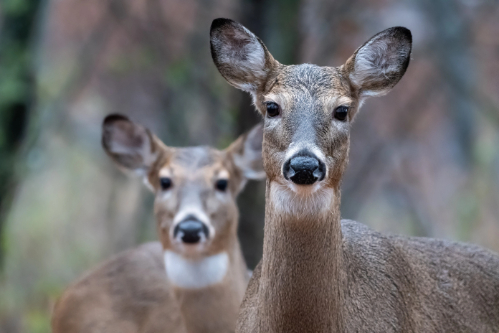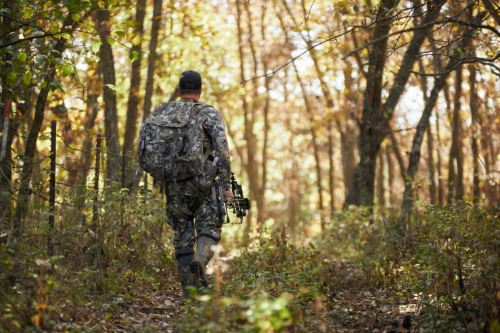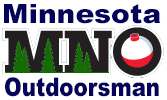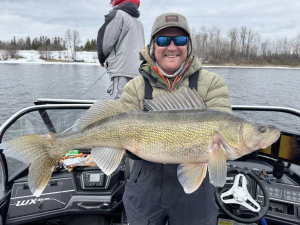The Latest Science Says Deer Can Essentially See in Slow Motion
A deer's ability to catch you moving is even better than we thought. Here's what it means for hunters and how you can still go undetected
by Adam Lewis

The Latest Science Says Deer Can Essentially See in Slow Motion
A tall and heavy 8-point buck pushed a doe up the open ridge and directly toward my tree stand. Three satellite bucks circled and sniffed the air, but couldn’t get within 20 yards of the doe due to the larger buck’s presence. Seventy yards of open timber separated us, but the doe was on a brisk pace and about to cross the ridge top saddle where I’d been waiting since before dawn. With seconds to prepare for a sure chip shot, I grabbed my bow and swung my camera to capture the scene. But I did it too quickly. Many years have passed since that morning hunt, but it still stings to think of that doe picking me off and leading that buck out of my life, forever.
Watching that dream crash and burn taught me a few lessons, but also made me wonder Just how well do whitetail actually see movement? So, I asked that question recently to one of the country's top deer researchers. The answer and its implications for hunters are actually worse than I imagined: Deer can see in slow motion.
The Latest Science on Deer Vision

A deer's ability to spot motion is up to four times better than ours. (Photo/John Hafner Photography)
Last year, I talked renowned research scientist Dr. Karl Miller, former professor at the UGA Deer Lab. He brought up the topic of flicker fusion rates (FF), also known as critical flicker frequency. FF rates determine an animal's ability to process visual information in one location, called temporal resolution. It’s measured by the frequency at which a flashing light appears to go steady. The higher this FF rate is for a species, the more information they can visually process per second. Numerous animal studies have shown that high FF rates mean a moving object is less likely to be blurred, and as a result, an animal's ability to determine its nature, direction, and velocity is increased. This is exactly what a prey species, like a whitetail deer, needs to survive in an environment full of dangerous predators with fangs, bows, and bullets—the ability to assess threats and quickly react to save their hides.
For humans the rate averages around 60 Hz in well-lit conditions. According to new studies, it may be up to 120 Hz for whitetail. Throw in the fact that deer are crepuscular (moving most during twilight periods) and have eyes uniquely suited to see in these low light conditions, and this makes their ability to see motion “up to four times ours” according to Miller. They are basically observing up to four subjective moments of reality per unit of time compared to our one. In other words, they are basically seeing in slow motion. This obviously gives deer an edge, and it means that any motion we make is magnified significantly to a deer compared to our perception of it.
What It All Means for Hunters

The latest science suggest that it's more important than ever to be stealthy walking to your stand and to sit still once you get there. (Photo: Mathews)
Most of us were taught to “just sit still” by our dads, grandpas, or other mentors. That's still great advice, but knowing what we now know about deer vision, it makes sense to be more cognizant than ever about extraneous movement. Here are half a dozen reminders and tips for how you can be more stealthy than even in 2025.
1. Befriend Barriers
There are times when you have no choice but to move, such as when you're walking to and from young stands or putting on a stalk or changing positions. Of course, the best way to go unseen is to go where you can't be seen. That is, behind hills, berms, screens of vegetation, downed trees, brush, etc. Rethinking the routes to your current stands, meticulously planning routes to new ones, and planting screening vegetation near stands ahead of the 2025 season can really pay off. You man have to walk farther or take a winding path to your stand to keep yourself hidden behind these barriers, but it'll be worth it when you punch your tag.
2. Still-Hunt Your Stand
If you can’t use a barrier, moving slower by up to two to four times, again according to science, can also pay off. Think of it like you’re stalking or still-hunting to your stand or blind, and take advantage of wind to mask movements when you can. Allow increased time and try to only move when trees, leaves, and grasses do.
3. Gear Down
I’ve hung up the camera and gone back to the basics. Getting rid of gear that makes you move more than necessary will decrease chances of getting busted. In particular, have an honest look at the motion you make when preparing for a shot, as this is the most motion a hunter will typically make in close quarters with deer. For archery hunters, if you can’t easily and slowly draw your bow straight back, seriously consider dropping a few pounds of draw weight so you can.
4. Double Down on Cover
Whether hunting in a ground blind or tree stand, think about ways to utilize more cover to disguise essential motion. I’m sometimes guilty of picking wide-open trees for stands, so gravitate toward those with lots of branches and consider adding your own if needed. If you can’t find a tree with ample cover, go with a ground blind that brushed in well, with the windows open as little as necessary to get off a clean shot.
5. Vet Your Camo
Another fact about whitetail vision is that they cannot distinguish fine detail. So, the job of camo is not to look exactly like leaves or limbs; it to generally break up your outline. Clothing with large macro camo patterns of contrasting shades and colors do this much better than those of a homogenous mix, which tend to “blob up” from a distance and make a hunter stick out. So inventory your gear and consider replacing those antiquated micro patterns.
6. Aim Higher
If you’re going to be in a tree, whitetail science would also support getting higher off the ground. Since deer have limited vertical vision without tilting their head, going just a few feet higher can effectively put you out of range of their slow-motion detectors.
Seeing the world through the eyes of a whitetail is essential for the savvy hunter. It won’t bring one particular buck waltzing back into my life, but it can help any hunter avoid critical mistakes due to a whitetail’s apparent ability to see in slow motion.









